In early December 2012 Steve Bisson, curator and founder of Urbanautica and Benetton Foundation brought together photographers Luca Capuano, Laura De Marco, Giuseppe De Mattia, Cristian Guizzo, Milo Montelli, Corrado Piccoli, David Wilson, Mitch Karunaratne, David Pollock, Kirsten Trippaers and the Spanish researcher Ruben Alonso in a workshop at Casa Luisa and Gaetano Cozzi of Zero Branco (Treviso) to investigate the neighboring agricultural landscape.
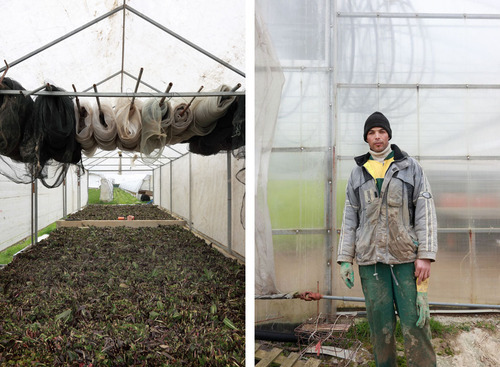
© Cristian Guizzo. A research carried out in farms and agricultural productions. Portraits of rural life at the dawn of the third millennium. We find mixed characters of the contemporary world, such as mechanization and non-EU workers, the rural tradition of crop rotation and parental solidarity.
This intensive one week’s work has its first public exposure through images and videos in the exhibition Zero Fotografia, designed by architect Massimiliano Foytik. The exhibition is open at ‘spazi Bomben’ of Benetton Foundation from Sunday 1 December 2013 through Sunday, January 12, 2014.
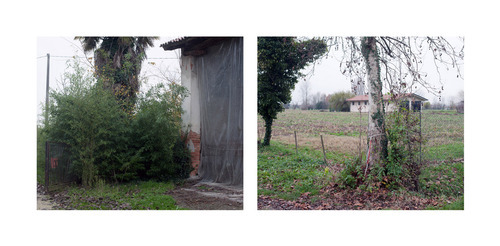
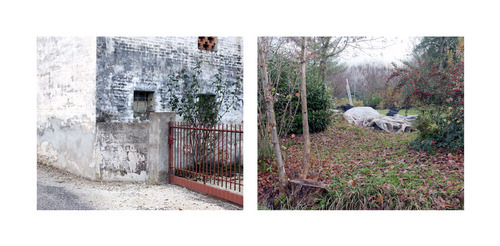
© Laura De Marco. The project limits the subject of housing to the relationship between the types and the land. The landscape “dialogues” with itself. She implements an operation of unaware photographic taking. Each initial photograph corresponds to a second picture of what is right in front of it.
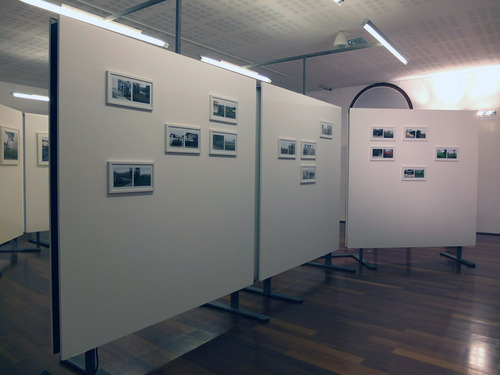
© Installation view of Laura De Marco, Zero Fotografia 2013
The title almost provocatively invites the visitor to question the contribution that photography can give to the reading of the landscape and, more generally, to what surrounds us. Each author has developed a theme through a process of personal investigation: the relationship between the types of housing and the environment in which they are placed, memories and traces, the impact of the infrastructure of the highway “Passante”, trees and vegetation, the industrial area, livestock and agricultural crops, fields, water and infrastructure, and finally the roads. These were the threads of research of the ten photographers. Each was called upon to make a contribution as a reflection on the modifications of the landscape between past, present and future with their own style and sensitivity.
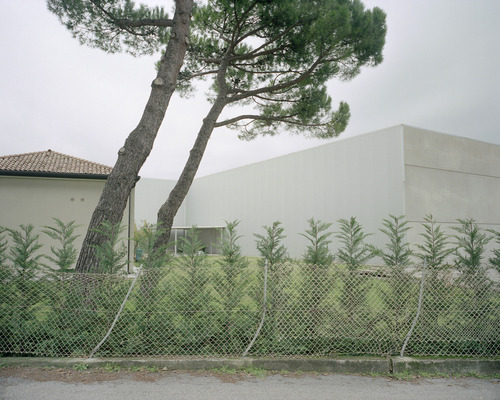
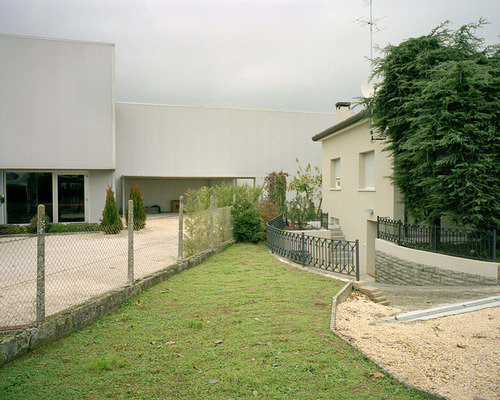
© David Wilson. The industrial theme is explored through the concept of proximity. Through the juxtaposition of the two spaces, residential and productive, Wilson reveals a close and unequivocal relation. Relentless shots as stones thrown in the eyes of the viewer.
«In this sense the workshop» explains Steve Bisson «has developed well beyond the initial expectations, encouraging participants to express their personality and not merely observe at the descriptive level. We are aware that much of what comes to us from the past is not entirely lost, and for this reason it must be witnessed. However let’s not forget the present, who we are, and where we are going, the future. It is essential, therefore, to keep alive our design skills. Each photographer brings his own reading of the assigned theme, an authorial interpretation.»
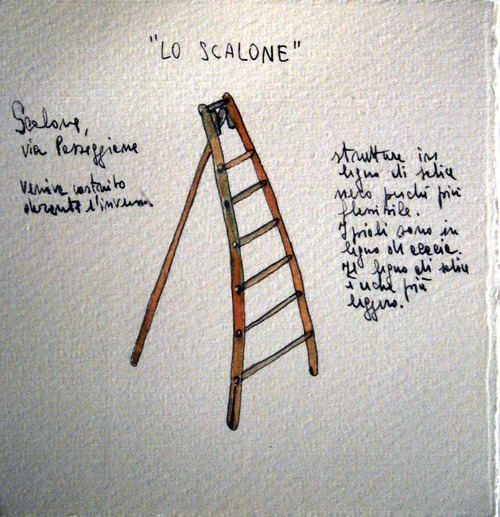
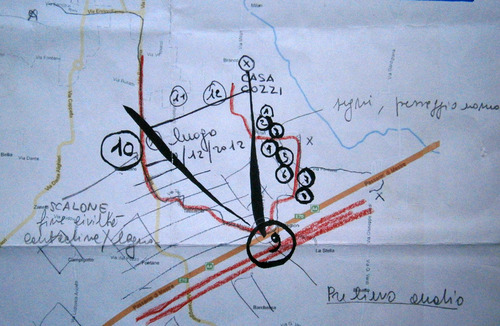
© Giuseppe De Mattia. The “Scalone” is about the ambivalence of the farmer who devoted himself to the fields in the summer, and the creation of tools for agricultural cultivation in winter. It is the symbolic trace of a “V” pattern that starts at Casa Cozzi, then bounces on the highway ‘Passante’ (returned through an audioscape), and ends at the “discovery” place of the object.
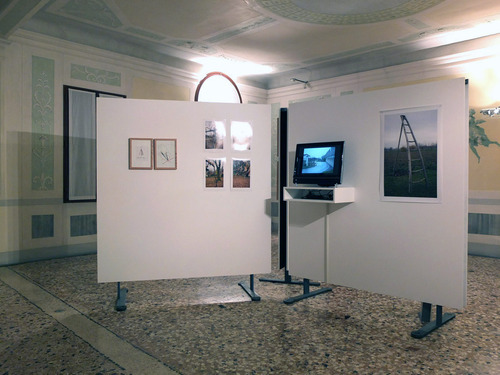
© Installation view of Giuseppe De Mattia, Zero Fotografia 2013
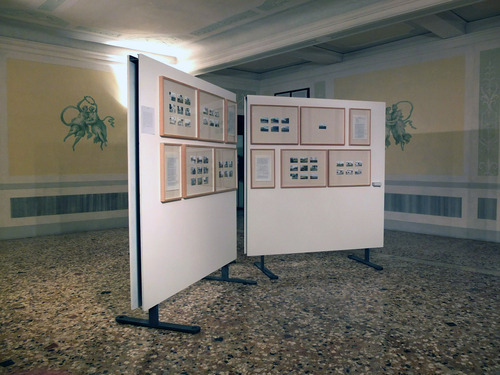
© Installation view of Luca Capuano, Zero Fotografia 2013.
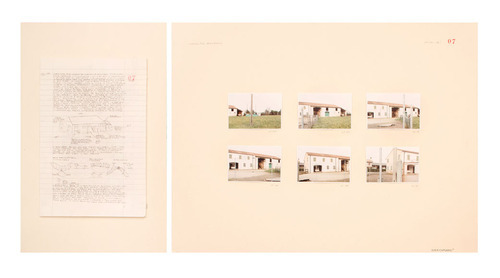
© Luca Capuano. The landscape is a cultural event and then open space of semiosis, a sign system that can not be defined uniquely. The territory documented by a mechanism of automatic writing, simple “data collection” in the form of images, and then subjected to the comparison based on textual memory.

© Kirsten Trippaers
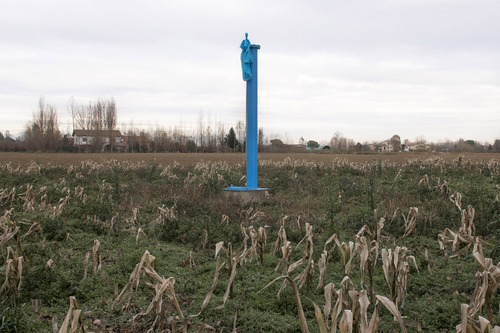
© Kirsten Trippaers. An essential theme is that of water. The Belgian photographer studies it by moving along its banks, and by noting with amazement the signs, curious and sometimes alienating, of its relation with the man. A blue pole in the middle of a field. Mysterious cabins along the banks of the river. Rusty structures in drained ditches and much more.
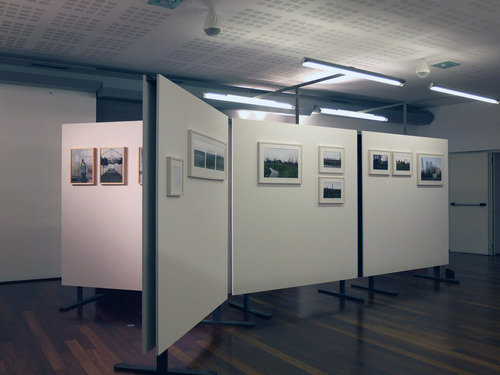
© Installation view of Kirsten Trippaers, Zero Fotografia 2013
The images in the exhibition are supplemented by interviews with the photographers, made during the workshop by Steve Bisson together with the researcher Ruben Alonso and post-produced with the support of Elisabetta Tasca. The results of this research will be published in a booklet (for now available only Italian from here) whose importance is underlined by the same editor in the introduction:
«Good or bad, right or wrong. Useful or not. I often read or hear about the landscape as a patient to be cured, or corrected. It’s almost as if we want to project into the landscape our inability to suffer along with our desire for eternal life. Everyone seems to have a prescription, a medicine for it.
I believe that photography can be used to ask questions rather than to provide outright answers. […] The fruits of the investigation are presented in this booklet that historicizes the need to deepen the relationship between photography and landscape, and to better assess the potential benefits that may arise from it.
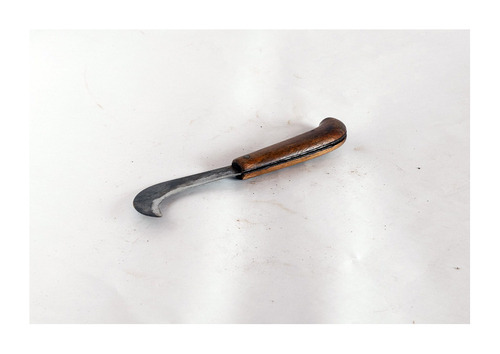
© Ruben Alonso. Some of the typical objects of the farmer found at Casa Cozzi. The working tools represent important cultural evidence of the relationship between man and earth, and of the rapid transformation of the agricultural civilization.
The work was carried out in three distinct phases: beginning, middle, and end of the workshop. This material in progress is therefore valuable to observe how the perception of the countryside of Zero Branco has evolved within the participants and consequently the footprint of their photographic project.
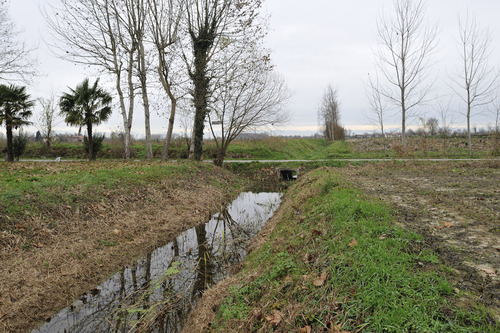
© Corrado Piccoli. The rural road for centuries remains an element of order that complements the landscape. Neither ugly nor beautiful, if anything necessary or useful. The new “modern” road pushes the interest to the form. The research highlights the progressive and rapid transition from simplicity to complexity. From the ethics of the function to the aesthetics of the project.
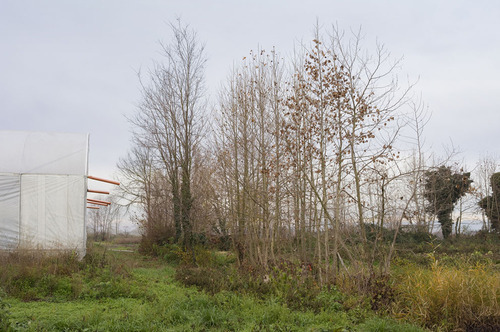
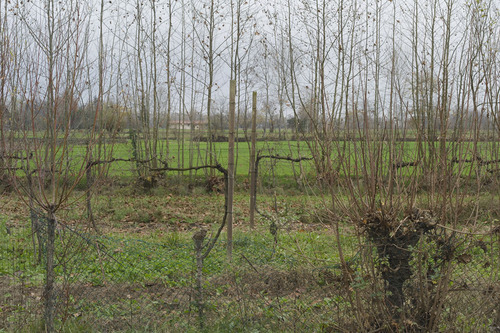
© David Pollock. A reading of farmland largely determined by its boundaries that define the space and its inhabitants. Photographs depicting the earth, with its residues and its winter blooms, together with the dense and complex plant barrier through which these elements are often filtered.
«Casa Luisa and Gaetano Cozzi, surrounded by eight acres of agricultural land» explains Marco Tamaro, director of the Fondazione Benetton Studi Ricerche «seemed to us, with its purpose as a laboratory of the agricultural landscape, the ideal venue for such an initiative of investigation on the modifications of the land. A theme that has always been dear to the Foundation’s work and that this time we wanted to explore, thanks to the collaboration of Urbanautica, through the medium of photography. A useful medium for thinking about the progressive transformation of rural areas and to highlight some of the critical issues of the area in question.»
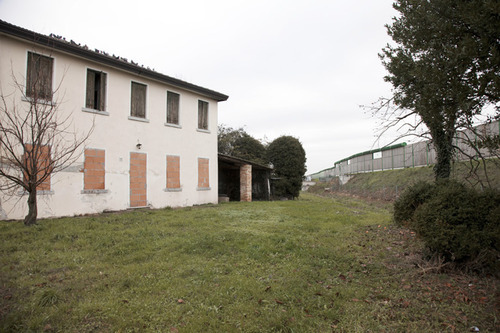
© Mitch Karunaratne. In the agricultural landscape of Zero Branco, cutting through the Roman heritage and its ancient mesh of fields adapted to the flow of water, opened in 2009, the so-called “Passante” of Mestre. Another six lanes of traffic and asphalt mark this landscape.
«Firstly, why?» explains Steve Bisson talking about the project, «the answer is quite simple and lies in what we see every day from the window of the train or the car while moving from one historical center to another. The “B side” of this landscape, the one that in the second half of the twentieth century has been subjected to an unprecedented intensive treatment of overbuilding. The reasons and the results of this rapid and often chaotic transformation of the agricultural landscape were examined by scholars from different backgrounds. It is needless to recall the many contributions of Fondazione Benetton Studi Ricerche in this regard. Nevertheless, this process continues, albeit attenuated by the crisis of the construction sector, despite lectures and election debates.»
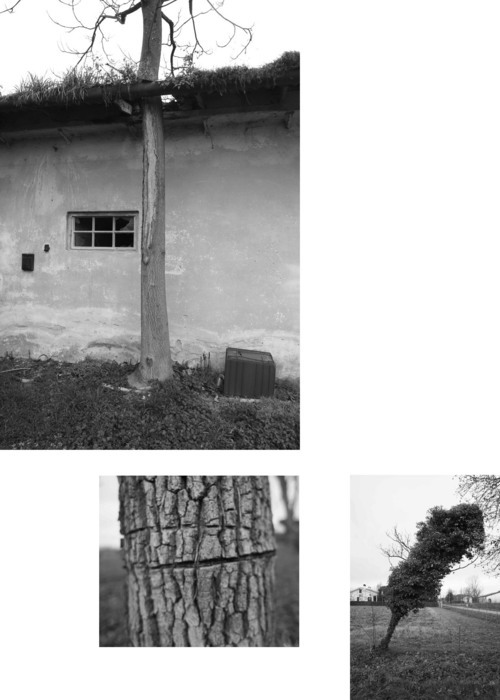
© Milo Montelli. The plants, the trees, the leaves almost survive the critical economic and social changes that cycle through each territory. The man leaves traces on the trees. The vegetation is an imperturbable witness and thus speaks of the silence.
«In the meantime, however, in the Veneto region, as in other regions of Italy, a growing circle of photographers, many of them architects, began to critically investigate this phenomenon through the means of photography. And it’s not just a reaction to the collective sense of helplessness that is experienced while observing the proliferation of “Capannite”* or the new examples of “Mouseton”. There’s more, there is the need to witness, to tell, to archive what is happening. There is the desire to communicate not only with the experts, but with the common people and to do so with new languages that are more immediate yet not trivial.» [* “Capannite” comes from “Capannone” (a big “Capanna” or cabin) the typical industrial building of the region. The word “Capannite” stands for an endemic spread of this type of settlement in the landscape.]
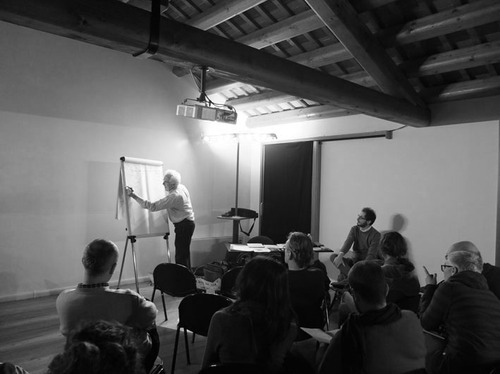
- The workshop included a series of introductory seminars by experts, aimed at facilitating the understanding of the territory by the participants. The landscape architect Domenico Luciani introduces his reading on the significance of the landscape. He leads the participants with a geographical analysis careful to distinguish the signs of the so-called “long-term landscape” from modern and recent peri-urban transformations.
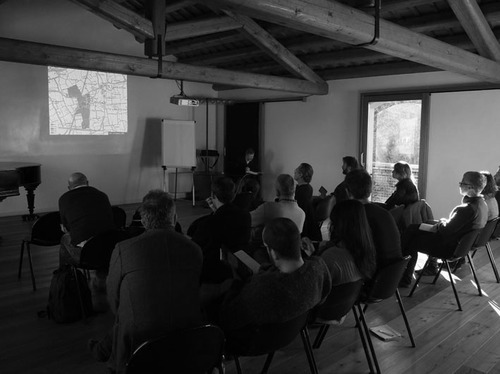
- The cartographer Massimo Rossi explains his spatial analysis of the case study, through maps, historical photos and aerial, drawings, maps. A way to facilitate orientation and geographic positioning among the participants. A precise explanation of the incidence of land transformations.
----
LINKS
Fondazione Benetton Studi Ricerche
Domus
share this page